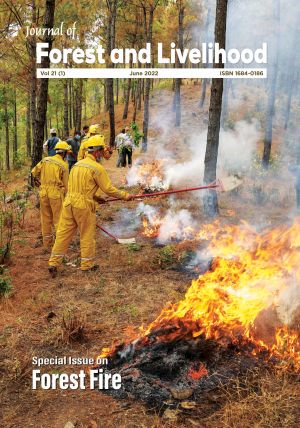Status and Practical Implications of Forest Fire Management in Nepal
DOI:
https://doi.org/10.3126/jfl.v21i1.56583Keywords:
Forest degradation, public finance, policy envision, sustainable fire managementAbstract
Forest fire occurs globally on various scales every year, causing economic, social, ecological, and environmental damage. In a developing country like Nepal, a critical review of policy envisions and its translation concerning the prevailing wildfire scenarios is lacking which is crucial for sustainable forest fire management. We examine the existing disaster management policies relevant to forest fire, and analyse forest fire incidences and their impact on forest cover loss and eCO2 (equivalent carbon dioxide) emissions using the data from Global Forest Watch (GFW) between 2001 to 2021. We also assessed public finance scenarios for forest fire management in Nepal and correlated and compared these data with each other. Our results find that the ‘Forest Fire Management Strategy 2010’ is the only comprehensive policy document that guides forest fire management in Nepal. Despite having low political and financial support (dedicated forest fire management budget is <0.5 per cent out of all forestry sector), awareness raising programme such as celebration of forest fire management week, broadcasting awareness raising messages and information, use of forest firefighting tools and equipements are some of the ground level interventions to prevent and control forest fire. GFW data shows that 29443 visual infrared imaging radiometer suite (VIIRS) fire alerts record (available only for 2012 to 2021), burns 207956.5 hectares (ha) area, 3.28 ha of forest cover loss, and 1132 Mg eCO2 emissions every year on average. These figures are 0.07 per cent, 0.05 per cent, and 0.0176 per cent compared to total forest cover loss, total emission (eCO2) from the forest, and proportion of tree cover loss to burnt area, respectively. Results entail that the existing forest fire management policy requires a revisit considering the changed national and international context, forest fire should be considered as a high priority by all sectors and actors because of its widespread socio-economic, ecological, and environmental impacts. Ignorance of forest fire management could severely hinder the target for national and international commitments including performance-based carbon trading and maintaining forest cover. The findings would provide insights for policy decisions to manage forest fires sustainably.
Downloads
Downloads
Published
How to Cite
Issue
Section
License

This work is licensed under a Creative Commons Attribution-NonCommercial 4.0 International License.
CC-BY-NC: This license allows reusers to distribute, remix, adapt, and build upon the material in any medium or format for noncommercial purposes only, and only so long as attribution is given to the creator.





